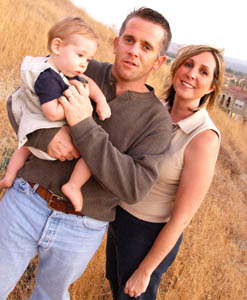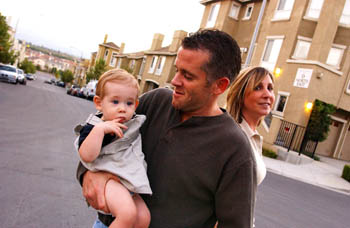![[Metroactive News&Issues]](/gifs/news468.gif)
[ Silicon Valley | Metroactive Home | Archives ]
Danger Underground: Joseph and Aimee Romeo worry for their son's safety in the face of their community's potential health risk.
Breathing Uneasy
Neighbors on asbestos-laden Communications Hill catch developers breaking a required precaution, but the developers say it's just dust in the wind
By Allie Gottlieb
AMBER RAIN fell on Marble Arch Avenue a few weeks ago, and resident Joseph Romeo worried that it might be toxic. Romeo had signed a form acknowledging the presence of asbestos in the ground when he bought his condo on Communications Hill in south San Jose a couple of years ago. He understood at the time that officials in charge of further development would follow all the steps required to keep the carcinogen under control.
That would mean preventing underground asbestos fibers from becoming airborne, a feat managed by keeping the ground wet during all construction. But on a recent Monday morning, grains of straw and dirt started blowing down the hill into the Lancaster Gate condo neighborhood where Romeo lives.
"When I came home, there was a huge cloud of debris in the air," Romeo says. "I wasn't sure what it was, but [I] flashed back to the waiver we signed when we moved into Lancaster Gate community stating there was asbestos in the ground ... but not to worry, when we grade the hills they will be wet so as to keep the asbestos from becoming airborne."
The refugee debris turned out not to contain asbestos, according to a test performed by MACS Lab at Metro's request. But the fact that builders had failed to contain the debris on-site is an ongoing concern for those living nearby. For one thing, it violates the construction standards the developer agreed to when its project was greenlighted following a series of environmental studies.
For another, the event raises red flags about how foolproof the city's hazard-mitigation measures are and how perfectly developers stick to them. These worries echo others concerning government officials' past failure to carefully monitor asbestos health risks at Communications Hill ("Dust in the Wind," March 11, 1999).
"Even a normal construction site is supposed to keep dust down," says Craig Breon, an environmentalist with the Santa Clara Valley Audubon Society, noting that the stakes are obviously much higher with the threat of serious health risks involved.
Toxic Rock
More types of rocks and minerals can be found in California than in any other state. Interestingly, of all the rocks in California, greenish-blue serpentine was given state-icon status in 1965, despite the fact that it produces asbestos.
"Just for perspective, serpentine is the state rock," Erik Yunker points out; Yunker is the Environmental Protection Agency's South Bay Superfund Site's guardian. "It's not that unusual to find asbestos-carrying rock. When [asbestos is] in rock form, it's not that dangerous because it's not that fibrous."
As the Audubon Society's Breon explains about asbestos, "It's possible that you could eat the stuff, and it might not hurt you much. Breathing it in gets it into your lung tissue."
In other words, the risk comes when something, like major construction, shakes free fibers within the rock. Chrysotile, nature's most common asbestos, is the type that forms in serpentine. Asbestos, which became popular as a flame retardant and insulating material, is now known to cause lung cancer, emphysema and mesothelioma (an obscure lung- and stomach-attacking cancer attributed solely to asbestos).
Communications Hill, a neighborhood named for the 115-foot-high AT&T communications tower and the Santa Clara County radio and microwave operations located there, includes about 130 acres of partially developed hillside land east of state Route 87 and along Hillsdale Avenue several miles south of downtown San Jose.
Because of the serpentinite rock underlying Communications Hill, construction at this site comes with three volumes of environmental conditions and various bureaucratic health and safety hoops requiring above-average government scrutiny.
"I remember learning how bad asbestos was for your lungs while in the Navy," says Communications Hill resident Romeo, 32. Anxious about potential health risks to his wife, Aimee, 33, and their year-old son, Conor, he complained about the debris from the construction to KB Home, the Fortune 500 company that is grading the hilltop to fill out its 700-plus-unit Tuscany Hills housing complex.
He was told not to worry. The debris was just straw used to prevent land erosion in preparation for the upcoming rainy season. In what seemed to Romeo at the time as if it could be some sort of coverup, the next day KB Home had people "on my street with those leaf blowers just blowing it around," he described in an email to the city's planning department.
Blame Game
Romeo's alarm makes sense, given that getting sick from asbestos fibers is a random process. It can take just one fiber to lodge in a lung and set off the evolution of disease.
City planning project manager Darren McBain responded to Romeo: "As a follow-up to your complaint, I have reminded KB Home staff that they need to keep the dust down in order to be in compliance with the environmental clearance that was granted for their project with regard to dust abatement."
Despite the relatively soft nature of the city's admonishment, it nevertheless suggests that KB Home goofed. KB Home, however, sees things differently.
Company officials swear they've followed every nitpicky rule set forth in the site's environmental regulation bible. KB Home president Drew Kusnick outlined the company's efforts to meet the local, state and federal regulations required for dust control in an Oct. 3 memo.
"KB Home maintains one 8,000-gallon tank and four 3,000-gallon tanks on-site and four to five water trucks during grading operations," the memo recites. It goes on to note the "expert soil engineers" on the company payroll and city building inspectors who oversee regulation compliance in order to demonstrate KB Home's commitment to following the rules.
But despite all these safety precautions, Romeo, a photographer, caught on video the result of KB Home breaking the dust-abatement policy. The city's November 2000 draft environment report is clear about dust abatement. It asserts that "the key to reducing the potential for significant asbestos emissions during subsurface activities in serpentine rock is dust control."
One KB Home public relations representative who offered her opinion but didn't want her name used in this article, called the city's environmental impact reports "outdated." She explained that the city wouldn't have approved KB Home's condo project if the company didn't already meet all of the requirements.
But supposedly, mitigation measures stand as ongoing guidelines to turn a potential cause for alarm, such as asbestos-containing rock, into a "less than significant impact." One mandate reads, "All working surfaces ... on material potentially containing asbestos shall be kept sufficiently moist so that visible dust is not emitted during grading or driving."
Another city regulation states that all workers have to go though training on asbestos hazards. A third demands that weekly "'tailgate' safety meetings must be conducted during the course of work to address specific issues and review basic provisions." Ultimately, the safety standards sound serious. KB Home points out that it was finished with its grading and earth-moving operations on Aug. 6, a month and a half before the debris incident occurred. But city environmental documents say nothing about the dust-abatement rules expiring.
The question is, if KB Home, under the city's watchful eye no less, breaks one basic rule, what's to assure residents that the company will follow all of the other ones?
Site developers do not believe they made a mistake. According to company president Kusnick and an on-site construction manager, the city was watching the whole time. City planning officials didn't respond to a request for comment regarding KB Home's suggestion that the city's officials are ultimately responsible.
According to city planning project manager McBain, last year KB Home sent three status updates four and five months apart each time showing permissible levels of airborne asbestos fibers. KB Home hired third-party Forensic Analytical Specialties to prepare these reports.
The EPA's Yunker laughed out loud upon hearing about this monitoring method. "People need to be spot checked every once in a while," he said. "Somebody should be enforcing those requirements."
[ Silicon Valley | Metroactive Home | Archives ]
![]()

Photograph by Dave Lepori

Kicking Asbestos: Residents of Lancaster Gate, such as the Romeo family, sign waivers acknowledging the presence of naturally occurring asbestos.
Send a letter to the editor about this story to letters@metronews.com.
From the October 9-15, 2003 issue of Metro, Silicon Valley's Weekly Newspaper.